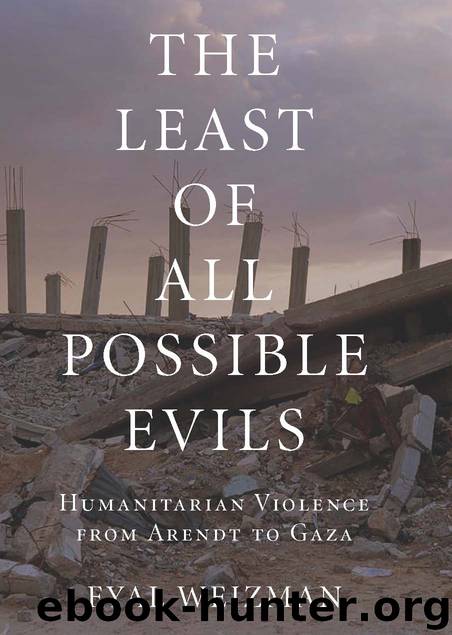The Least of All Possible Evils by Eyal Weizman

Author:Eyal Weizman
Language: eng
Format: epub
Publisher: Verso Books
Published: 2012-06-05T04:00:00+00:00
Marc Garlasco speaking at Bard College’s Human Rights Project (HRP) about violations of the laws of war in the Gaza offensive of 2008–9. Photograph courtesy of HRP, 2010.
4
Forensic Architecture:
Only the Criminal Can Solve the Crime
The love of ruins has generated various epistemes and disciplines: In the sixteenth century it informed philology, in the nineteenth century historiography and criminology . . . [now] the physis of the fragments took the place of virtual debris and the love of ruins became a fetish.1
Cornelia Vismann ‘The Love of Ruins’
A strange story unfolded in the shadows of the legal and diplomatic furore that accompanied the release, on 15 September 2009, of Richard Goldstone’s ‘Report of the United Nations Fact Finding Mission on the Gaza Conflict’. The report alleged that both the Israeli military and Hamas had committed war crimes, and indeed that Israel might even be guilty of ‘crimes against humanity’.2 On the same day, Human Rights Watch (HRW), still in the process of conducting its own in-depth analysis of Israel’s invasion of Gaza in early 2009, announced the suspension of its ‘senior military analyst’ and ‘expert on battle damage assessment’ Marc Garlasco. Garlasco had joined HRW’s ‘emergencies division’ in 2003 after seven years as an intelligence analyst in the US Defense Intelligence Agency, where he was a ‘targeting’ and ‘battle damage assessment’ expert. During NATO’s attack in Kosovo and Serbia and the subsequent US-led attack on Iraq, Garlasco had been involved in selecting bombing targets and the munitions for their destruction, and also in the ‘proportionality assessment’ that designated the maximum number of civilian deaths for bombing missions to comply with international humanitarian law. Crucially, these military tasks meant that he had to familiarize himself with the structure and construction techniques of buildings and with the way they collapse, a skill that was later of use in his role as Human Rights Watch’s in-house forensic expert in charge of examining battle damage. At HRW his investigations had focused largely on the examination of material remains – building rubble and shrapnel – found in the aftermath of attacks, and on military technology used. Providing crucial material evidence and expert analysis for HRW’s research on violations of IHL and human rights in Iraq, Afghanistan, Lebanon, Gaza, Myanmar and Georgia,3 he built up a considerable professional reputation, a media presence, and quite a few detractors (mainly with those human rights people that did not like a former soldier in their midst, but also those against which he wrote) , and, by the time of his suspension, had authored and contributed to a series of reports alleging violations of international humanitarian law by the Israeli military, in both its Gaza offensive and a string of earlier incidents.4 In the Goldstone report, the reports he worked on were cited on thirty-six occasions.
Some 1,400 people were killed and 15,000 buildings destroyed or damaged in the Gaza attack of December 2008–January 2009.5 There is, unsurprisingly, a correlation between these figures: a large proportion of the deaths occurred within buildings. Indeed,
Download
This site does not store any files on its server. We only index and link to content provided by other sites. Please contact the content providers to delete copyright contents if any and email us, we'll remove relevant links or contents immediately.
| Anthropology | Archaeology |
| Philosophy | Politics & Government |
| Social Sciences | Sociology |
| Women's Studies |
The Secret History by Donna Tartt(16653)
The Social Justice Warrior Handbook by Lisa De Pasquale(11492)
Thirteen Reasons Why by Jay Asher(7797)
This Is How You Lose Her by Junot Diaz(5791)
Weapons of Math Destruction by Cathy O'Neil(5045)
Zero to One by Peter Thiel(4832)
The Myth of the Strong Leader by Archie Brown(4795)
Promise Me, Dad by Joe Biden(4453)
Beartown by Fredrik Backman(4429)
Stone's Rules by Roger Stone(4421)
How Democracies Die by Steven Levitsky & Daniel Ziblatt(4407)
The Fire Next Time by James Baldwin(4349)
100 Deadly Skills by Clint Emerson(4084)
A Higher Loyalty: Truth, Lies, and Leadership by James Comey(4038)
Rise and Kill First by Ronen Bergman(4017)
The David Icke Guide to the Global Conspiracy (and how to end it) by David Icke(3890)
The Farm by Tom Rob Smith(3878)
Secrecy World by Jake Bernstein(3787)
The Doomsday Machine by Daniel Ellsberg(3736)
